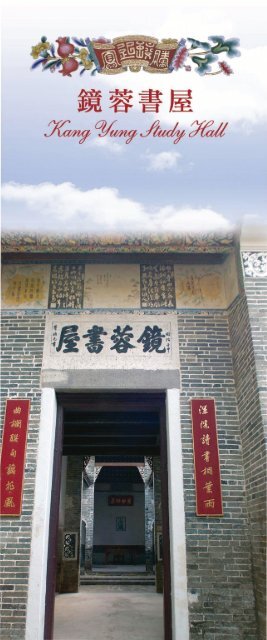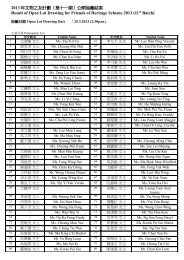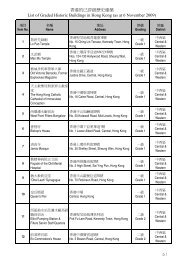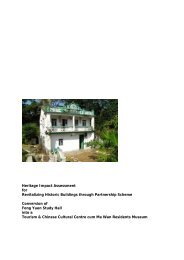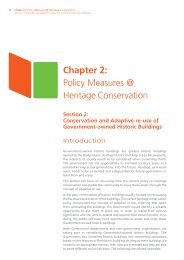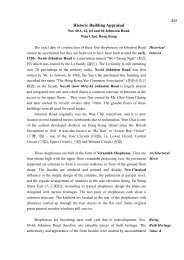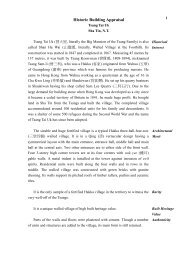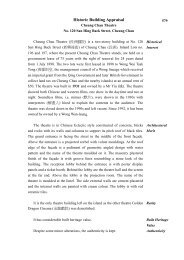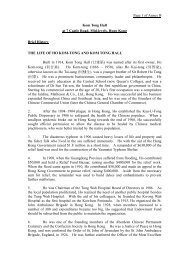Kang Yung Study Hall (revised in Sep 2010)
Kang Yung Study Hall (revised in Sep 2010)
Kang Yung Study Hall (revised in Sep 2010)
Create successful ePaper yourself
Turn your PDF publications into a flip-book with our unique Google optimized e-Paper software.
-~-~<br />
~OJ/~./~ :Ytdt
~ #L ~ ,re Li Clan ofWo Hang<br />
+-=t!t~cMWl<br />
Early 13th century<br />
+ -t t!t ~cat Wl<br />
Late 17th century<br />
fi<br />
~<br />
0<br />
•'-§>~<br />
e ltEBoluo<br />
-~-~83t:Pmt~7KtJt;f;f$:~<br />
~A-~o:$~~~*A'~<br />
fll~*ft*!f: (-t~ttUC.1JJ)<br />
J-Em11~;Jt~$%~A~m<br />
JlJ!t~iW/.Iti<br />
0<br />
~1680!f:ft~<br />
M'*••~~rttif*ilm~<br />
m1(ti (~~Jl1(ti) 7KtJL, .ML<br />
~:f[7KtJct-fo<br />
17Kf1LJ , ~~~ ,'it',fH!~11:ft<br />
;m*I¥J~:lif!o]f:$1l-~*·<br />
if*ilm7KtJcffif , 1~M7.K~ '*P*<br />
~it~~~ ' 1£7KfJtfJt tl~:li!!~<br />
t-f,JV(;~I3~1¥JL7KtJct-fo:$<br />
ttif*rxri¥1~AJt~il~~lli<br />
:li!!:lJ, ~%~U.r.J1£173o!f:li<br />
1 7 so!¥ ~:fl. r 7Kf1Lli7Kf1L:X ~<br />
=t-fo<br />
The <strong>Kang</strong> <strong>Yung</strong> <strong>Study</strong> <strong>Hall</strong> was founded by the Li Clan ofWo Hang Village <strong>in</strong><br />
Sha Tau Kok. The ancestors of this Hakka clan had settled <strong>in</strong> Fujian prov<strong>in</strong>ce at<br />
the end of the Song dynasty (early 13th century), and some of their descendants<br />
later migrated to Boluo county <strong>in</strong> Guangdong prov<strong>in</strong>ce. In the late 1680s, Li<br />
Tak-wah and his son Li Kuen-lam moved from Boluo to Wo Hang <strong>in</strong> X<strong>in</strong>'an<br />
county (later renamed Baoan), where they laid the foundations for the village.<br />
Wo Hang literally means "valley of rice". When Li Tak-wah and Li Kuen-lam<br />
moved to the area, they took the advice of Li Sam-yau, a feng shui expert, and<br />
established their village near the mouth of the valley. This village was then called<br />
Sheung Wo Hang (Upper Wo Hang). The descendants ofKuen-lam's second son<br />
branched out to found two other villages, Ha Wo Hang (Lower Wo Hang) and<br />
Wo Hang Tai Long, <strong>in</strong> around 1730 and 1750 respectively.<br />
Descendants of the Li Clan still reside <strong>in</strong> these three villages <strong>in</strong> Wo Hang today,<br />
although s<strong>in</strong>ce the 1950s many have moved to urban areas <strong>in</strong> Hong Kong and<br />
even abroad, mostly to Jamaica and England.<br />
* ~:ti*.AJI:ft~~ Iii<br />
Migration route of the Li Clan from<br />
ma<strong>in</strong>land Ch<strong>in</strong>a to Wo Hang<br />
it&*~~Amffif1J3m~7KtJL<br />
~t-t ' 1.§. $%t-f ~ § 1950!f:ft<br />
®B~*ilf±rlllii,]!:ff$%<br />
~mtflt5tr<br />
:lif!o<br />
, ~of~1Joli~~~~<br />
<strong>2010</strong>~%;:1;Jt.:::;ft,~~lii ' itll!~f.ig·~-~ 0<br />
An aerial photo show<strong>in</strong>g the three villages <strong>in</strong> Wo Hang <strong>in</strong> <strong>2010</strong>;<br />
<strong>Kang</strong> <strong>Yung</strong> <strong>Study</strong> <strong>Hall</strong> is circled <strong>in</strong> yellow.<br />
An aerial photo show<strong>in</strong>g Sheung Wo Hang <strong>in</strong> the 1950s
II~ 3 §! <strong>Kang</strong> <strong>Yung</strong> <strong>Study</strong> <strong>Hall</strong><br />
~~~H·:j_~J -~PJ~~V!l±l!lft (618-907if) ~~5:\ (803-863if)<br />
I]{J~~;j\~ f@llJMJ$~_§J o i'iJC¥tiff~'$~1§ (782-860if:) ~~<br />
••·~~-~~•·~Wm1ifr~~~if~•~~~~J~<br />
r•=e~~J o'$~-~~~if~s:\·W~M~~~AM~<br />
·J-M;=+if•·~~~-7$~o<br />
•~z~!J)\PJ~~w~•• oa31-19ooif) ~~~ ~~~187lif:<br />
0<br />
~~~±·*~$*~~1]{J~~·W~~-~I]{J~~Wo:t:~<br />
*~~~•J ·*~~n~¥~~•~*·~*~13~~-~<br />
-:+l*1~~~z~ o<br />
~~--~J lm'=¥~'$!'&5U±Fill~+-if (1872if) EJTM o '$~<br />
~-~*~-~-~¥~·1ff·~--~$if·~~-~*<br />
~*~•~*~•ffim¥*~~-~ 0<br />
~~*$*•~~•m~~~·~•-=~~~~-R~••*<br />
ffl~I]{J•~·ft*&~7*~*~~A~ft£mx•I]{J~~o<br />
-~~-~-~~~-MR~li~+~M~~~-MI]{JUMo<br />
~~if:M (1736-1795if) , :t:~BJl:-~m~ o 1872if:-1IH'lz£f~ ,<br />
~P<strong>in</strong>~Fillif•~••••~·ffi!J)\~M~~m•si]{J•~~<br />
M~lf.o<br />
•••~~~~*~~*~~ (*~) ~mhoo~-~~·~<br />
-=~~•-E!T•~BB•i]{]~m¥m, I!/BI:::r-~fX£*:1tti, tprn~<br />
~~itm1W**~>lf ;J\¥ • 1i~l986i:F~*:i:•-11t¥~~<br />
~·~JE:J:\~*0<br />
"<strong>Kang</strong> <strong>Yung</strong>" literally means "mirror and hibiscus': and it is thought that the name<br />
that the Li Clan gave to their study hall may have orig<strong>in</strong>ated <strong>in</strong> a legend described<br />
<strong>in</strong> the anecdote You Yang Za Zu written by Duan Chengshi (803-863) dur<strong>in</strong>g the<br />
Tang dynasty (618-907). After fail<strong>in</strong>g the civil service exam<strong>in</strong>ation, a would-be<br />
official named Li Guyan (782-860) travelled to Sichuan, where he met an old<br />
woman who foretold that Li would succeed <strong>in</strong> the exam<strong>in</strong>ation the follow<strong>in</strong>g year<br />
under a hibiscus-shaped mirror and ascend <strong>in</strong> 20 years' time to the post of prime<br />
m<strong>in</strong>ister. Sure enough, Li was ranked first <strong>in</strong> the follow<strong>in</strong>g year's exam<strong>in</strong>ation, <strong>in</strong><br />
which candidates were asked to write a poem entitled "Hibiscus-shaped mirror";<br />
the prophecy was completed 20 years later when Li became prime m<strong>in</strong>ister.<br />
A more immediate, and possibly more likely, reason for the nam<strong>in</strong>g of the study<br />
hall was the success ofTang <strong>Yung</strong>-kang ( 1831-1900), who was awarded the grade of<br />
j<strong>in</strong>shi <strong>in</strong> 1871. The honourary plaques of Tang <strong>Yung</strong>-kang are found <strong>in</strong> some<br />
ancestral halls of Tang dans <strong>in</strong> the territory. This event would have had a tremendous<br />
impact, and it is safe to assume that the <strong>Kang</strong> <strong>Yung</strong> <strong>Study</strong> <strong>Hall</strong> was named to<br />
<strong>in</strong>spire students to emulate Tang <strong>Yung</strong>-kang's success as well as that ofLi Guyan.<br />
The four Ch<strong>in</strong>ese characters "<strong>Kang</strong> <strong>Yung</strong> Shu Uk" that can be seen above the ma<strong>in</strong><br />
entrance were <strong>in</strong>scribed by Li Pui-yuen <strong>in</strong> the 11th year of the Tongzhi reign<br />
(1872). Li was a famous Wo Hang scholar who spent many years teach<strong>in</strong>g at the<br />
study hall and who notably coached one of his pupils, Li Cheung-chun, to first<br />
place <strong>in</strong> the district exam<strong>in</strong>ation (xiucai) <strong>in</strong> Guangzhou.<br />
In contrast to most study halls <strong>in</strong> the New Territories, which were also used as<br />
ancestral halls, the <strong>Kang</strong> <strong>Yung</strong> <strong>Study</strong> <strong>Hall</strong> is a rare example of one that was built<br />
solely for teach<strong>in</strong>g purposes. It served as vibrant testimony to the respect and<br />
commitment that generation after generation of the Li Clan devoted to scholarship.<br />
The study hall was orig<strong>in</strong>ally established <strong>in</strong> the form of a sishu (private study hall)<br />
dur<strong>in</strong>g the early Q<strong>in</strong>g dynasty, cater<strong>in</strong>g for five to ten students from the dan. It was<br />
then converted to a two-storey build<strong>in</strong>g dur<strong>in</strong>g the Qianlong reign ( 1736-1795 ).<br />
The study hall was renovated aga<strong>in</strong> <strong>in</strong> 1872 and probably received its name <strong>Kang</strong><br />
<strong>Yung</strong> <strong>Study</strong> <strong>Hall</strong> the same year, although some villagers have suggested the name<br />
was <strong>in</strong> use earlier.<br />
Earn<strong>in</strong>g renown for its achievements <strong>in</strong> prepar<strong>in</strong>g students to qualify as shengyuan<br />
or xiucai <strong>in</strong> the civil service exam<strong>in</strong>ations, the board<strong>in</strong>g study hall attracted<br />
students from as far afield as Tai Po, Sha T<strong>in</strong> and Tsuen Wan.<br />
The study hall was later converted <strong>in</strong>to a primary school, which was then dosed<br />
when the last pupils departed <strong>in</strong> the summer of 1986.<br />
Students of the <strong>Kang</strong> <strong>Yung</strong> School, July 1950<br />
Jiltftjjll:Jl\t~ (@~~HID
H! • ~ {g Architectural Features<br />
iE r ~ _t i¥J ,!\tli».::Jc '¥<br />
Murals and calligraphy above<br />
the ma<strong>in</strong> entrance<br />
JEm~::ff r•~i!fE~IJ i¥1rnf!<br />
The fascia above the ma<strong>in</strong> entrance with the <strong>in</strong>scriptions "<strong>Kang</strong> <strong>Yung</strong> Shu Uk"<br />
-~-~~-~~~~~~~~~,~~~~* o•~¥~n<br />
JB' W.wii!JHJJJJVt' ~!};JJ!UW.*~~~~~~;f!l~±f'F~~ o ~T<br />
~M··~·-·*'·~-~~~··*W.M¥Wm~~o<br />
~~m~~-~;f!l~~#A~,M•m~~~•m~~m · ~<br />
r, rH1Jt.t~:Jm~Mffi , -~1£1WH€i+-:1f ( 1872:1:¥) ~q:r~iX::k~JHl~~{~I;f¥.<br />
o<br />
A decorative jo<strong>in</strong>t bracket<br />
under the eaves board<br />
A two-storey build<strong>in</strong>g with two halls separated by an open courtyard, the <strong>Kang</strong><br />
<strong>Yung</strong> <strong>Study</strong> <strong>Hall</strong> is a rectangular structure built with green bricks; the <strong>in</strong>ternal<br />
partitions are constructed of unfired mud bricks and rammed earth. Its architecture<br />
is simple and functional, with the exception of some f<strong>in</strong>e decorations at the<br />
entrance. The rooms on the ground floor were used as classrooms and teachers'<br />
common rooms, while the cocklofts provided accommodation for board<strong>in</strong>g<br />
students. As the <strong>in</strong>scriptions on the fascia above the entrance <strong>in</strong>dicate, a major<br />
renovation was carried out <strong>in</strong> the 11th year of the Tongzhi reign ( 1872).<br />
Eil llii¥1~-<br />
Murals under the roof<br />
jj:!J}<br />
Sid!! Room II<br />
II<br />
II<br />
lEE<br />
Ma<strong>in</strong> <strong>Hall</strong><br />
lj:~<br />
II Side Room<br />
II<br />
II<br />
:f!1r~iEill:J'# ::ff1'L T-iH~ o<br />
A portrait of Confucius hangs <strong>in</strong><br />
the ma<strong>in</strong> hall.<br />
:Jlk""f .>jZ-jlijliJ<br />
Ground Boor plan<br />
M~.>jZ-JiiiliJ<br />
Cocklofr plan
f~ fi I ft Restoration Works<br />
1~~-ru-~1¥1 r~•<br />
The entrance hall before and after restoration<br />
Restoration <strong>in</strong> progress<br />
-~-ffi~l99li¥4Ji 7tl~~5EttHI , ~
N<br />
®<br />
D<br />
.fi! ••<br />
<strong>Kang</strong><strong>Yung</strong><br />
<strong>Study</strong> <strong>Hall</strong><br />
i};!:t;~A Public Transport<br />
B Kowloon Motor lmL(KM8)<br />
78K 1::7.1~Jil<br />
Sheung Shui - Sha Tau Kok<br />
••'J'B Green M<strong>in</strong>ibus {GMB)<br />
55K 1::7.1~Jil (JIIi'i~W)<br />
Sheung Shui Station- Sha Tau Kok (Shun Lung Street)<br />
56K<br />
ffl'~:\ii!i-~~<br />
Fan l<strong>in</strong>g Station- Luk Keng<br />
J;),_t~im~~R1M~~ · :tm~:t:i!.JI: · ~~~~i!j~Ull!ltlm1\11'6~fil~~ o<br />
The above transport <strong>in</strong>formation is for reference only, and is subject to change <strong>in</strong> accordance with the<br />
transport companies or the Transport Department.<br />
hl Venue<br />
AA'~ZI>~ftrll::~t!L<br />
Sheung Wo Han~ Sha Tau Kok, New Territories<br />
.81::~~~~~~-~&~~=~~li~<br />
£ml= · 7L..EL8 · .&M*fi1:FW-~W.::: · ~~8&~~~8'f*,\l!,<br />
9am-1 pm and 2pm-Spm daily<br />
Closed on Tuesday, New Year's Day, the first three days of the Ch<strong>in</strong>ese New Year,<br />
Christmas Day and Box<strong>in</strong>g Day<br />
i!f~<br />
~ )lg~ZJ>~il.<br />
)tij:~.ffi~~~[i]<br />
w~x~~~Mr<br />
~~i§: 2208 4400<br />
f$J1j;: 2721 6216<br />
~:Ill:: http://www.amo.gov.hk<br />
Enquiries<br />
Hong Kong Heritage Discovery Centre<br />
Kowloon Park, Haiphong Road,<br />
Tsim Sha Tsui, Kowloon<br />
Tel: 2208 4400<br />
Fax: 2721 6216<br />
Website: http://www.amo.gov.hk<br />
© 2013 ~~.&.3cft.$ffl¥<br />
0 0<br />
)'&j;(,Pfi~ • *~~fOJ1'f~llmfll iil~l!lt~tt<br />
© 2013 Leisure and Cultural Services Department<br />
All rights reserved.<br />
2013"¥8Jl tiED<br />
Pr<strong>in</strong>ted <strong>in</strong> August 2013<br />
IIUl~ Jit!l: f~$D•<br />
Leisure and Cultural<br />
5ervioes Department


